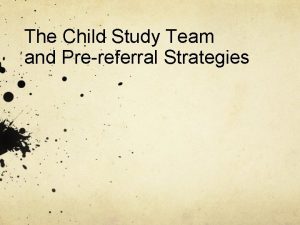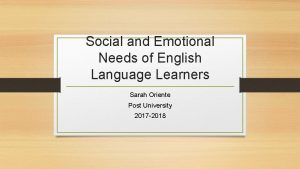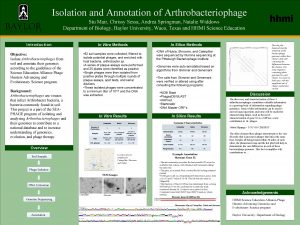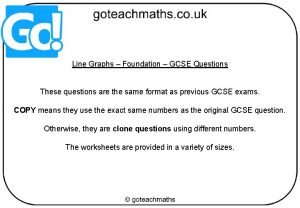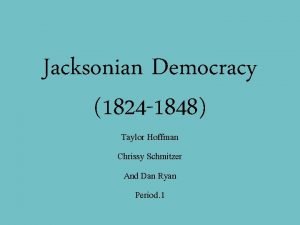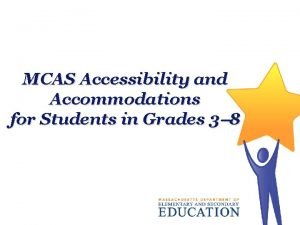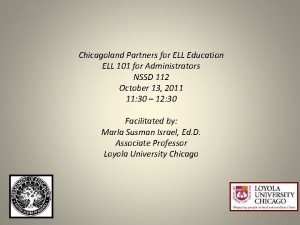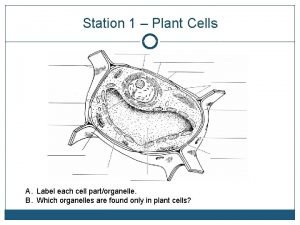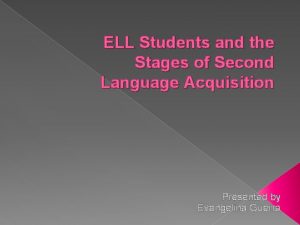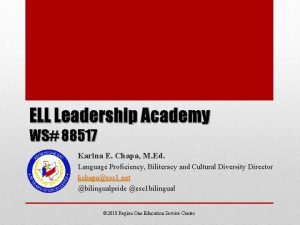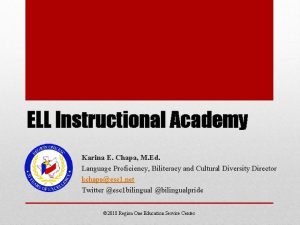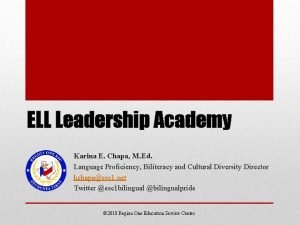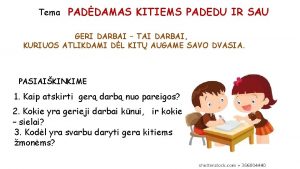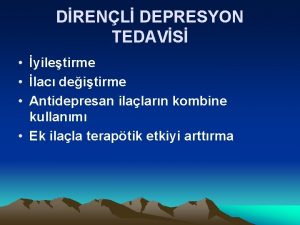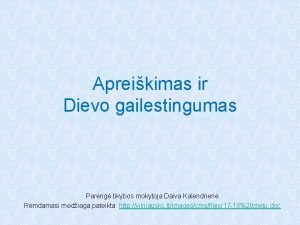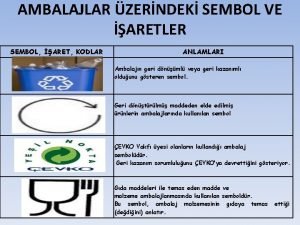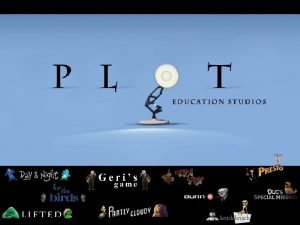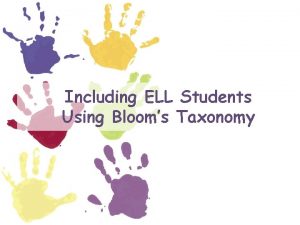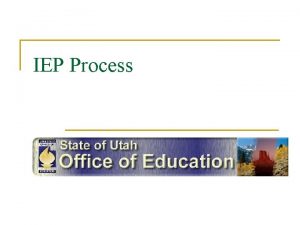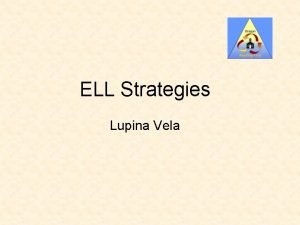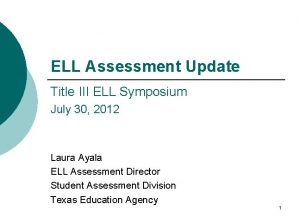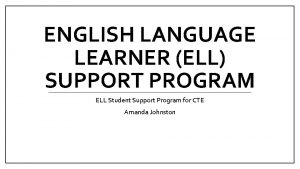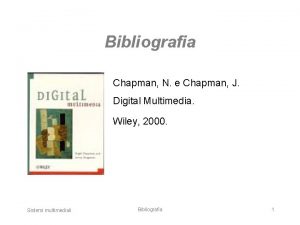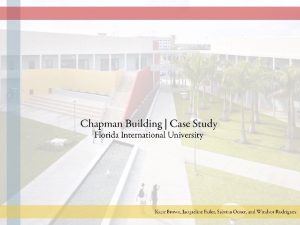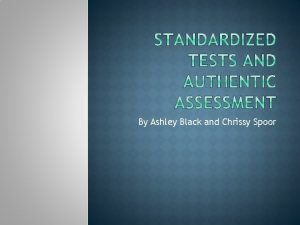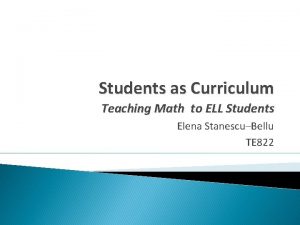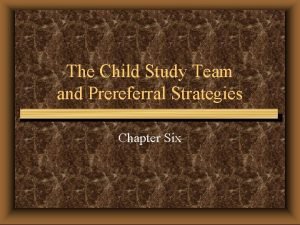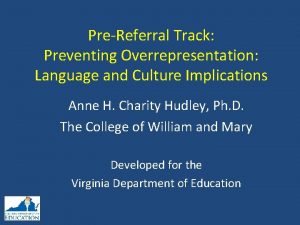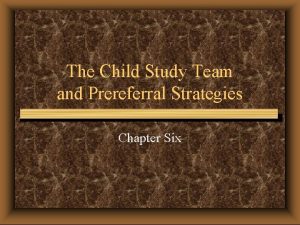Prereferral Process for ELL Students Chrissy Chapman Geri


































- Slides: 34

Pre-referral Process for ELL Students Chrissy Chapman Geri Holland Aimee Boswell-Rea Salem-Keizer Public Schools 2014

Why are we here? n To understand the appropriate process for evaluating and serving culturally and linguistically diverse populations. n IDEA 2004 expressly requires districts must submit a plan of policies and procedures designed to prevent the inappropriate over identification or disproportionate representation by race and ethnicity of children as children with disabilities.

Myth 1 n Myth: If we label an EL as learning disabled, at least he will get some help. n Studies have shown that Hispanic students who were classified as learning disabled performed at a lower level after three years of special education placement (Wilkinson & Ortiz, 1986). Special ed. interventions tend to target a narrow selection of skills to enable mastery, and discrete skills are often practiced out of context. Interventions often use reading materials with controlled phonics and vocabulary, which reduces the meaningfulness of the text. This constricts language usage and makes it more difficult for ELLs to understand retain information (Gersten & Woodward, 1994) Instructional Models

Identification should not serve the purpose of “getting extra help”, we need to provide the right kind of help § Effective EL Instructional Practices are the first line of defense § Interventions are the second line of defense § Teacher led small groups in the classroom § School wide targeted interventions groups/reading specialist/effective learning teachers Implementing RTI with English Learners by Douglas Fisher, Nancy Frey, Carol Rothenberg

Adherence to a Consistent, Effective Instructional Model for ELs n n Instructional Coaching Research Based Practices q EL Achieve n n q q Systematic ELD Constructing Meaning GLAD & SIOP Bilingual Programs n n Dual Language Literacy Squared


Implementation n Focused and Integrated ELD n Native Language Supports n Scaffolds n Gradual Release of Responsibility n Data Teams n Interventions/Supports n Pre-SST

Focused and Integrated ELD n n n is driven by ELP standards and addresses posted language objectives is strategically scheduled and consistently planned to teach specific target academic language which supports all content, especially literacy includes 4 domains: reading, speaking, listening and writing is differentiated to provide instruction for all proficiency levels as noted on class maps requires ongoing assessment (monitoring) of language development

Myth 2 n Myth: When an EL is identified as having a disability, instruction should be only in English, so as not to confuse the student. n Children with speech, language, or learning impairment can become fully bilingual (Genesee, Paradis, & Crago, 2004). Developing the native language can help students make better progress in the second language. n n Poor understanding of cultural and linguistic differences Over emphasis on standardized tests

Native Language Supports Literacy Squared and Dual n n n n Research Project PD for Leadership & Teachers Assessment Focused on Examining Biliteracy Spanish Literacy Based ELD (focus on oracy) Oral Language Development Explicit connections between S & E

The Bi-literacy Zone EDL DRA English Only K A-6 A-2 A-3 1 8 -10 3 -6 4 -16 2 12 -16 8 -10 18 -28 3 18 -28 12 -16 30 -38 4 30 -38 18 -28 40 5 40 30 -38 50 6 50 -60 40+ 60+

Considering the Bi-literacy Zone Advanced Students who consistently perform at a minimum of one grade level above on EDL OR DRA, and meets or exceeds the corresponding bi-literacy zone Benchmark Students who consistently perform at grade level on EDL OR DRA, and falls within the corresponding bi-literacy zone Strategic Students who consistently perform below grade level on EDL OR DRA OR do not fall within the corresponding the bi-literacy zone Intensive Students who consistently perform far below grade level (2 or more years) on EDL AND DRA, AND may not fall in the bi-literacy zone trajectory

Effective Instruction for ELs n Sheltered Instruction q q n n GLAD/SIOP CM Comprehensible Differentiated Gradual Release of Responsibility Content/Language Scaffolds n Gradual Release of Responsibility

CONTENT AND LANGUAGE SUPPORTS ACTIVITY Gallery Walk: • • • Walk around to each poster Determine whether it is a language support or content support Write on your sheet ‘L’ for language scaffold or ‘C’ for Content scaffold

Strengthening Core Instruction for English Learners Content Supports Language Supports Mini-Shared Reading Process Grid Dialectical Journal Word Sorts Dictado One, Get One Draft Text File Cards Graphic Organizer Illustrated Word Bank Echo/Repeat Clock Appointments Genre Template Team Tasks Pantomime/Gestur es Sentence Stems/Frames Choral Response Lines of Communication Cognitive Content Dict. Poetry Frames/Chants 10/2 Sent. Patterning Chart My Turn, Your Turn Busy Bees Coop. Strip Paragraph Listen & Sketch Lotta Lara Multiple Meanings Talking Stick/Ball/Chips Inside Outside Circle Pictorial Input Chart Ear to Ear Rdg. Big Book Word Families Board Game Lingo Bingo Team Tasks Collaborative Posters Observation Charts Frayer Model Structured Role Play I Have, Who Has Reading in Four Voices Numbered Heads Reciprocal Reading Vieja Ines Whip Around Tea Party

Data Teams n n Oregon DATA Project: Direct Access to Achievement Grade Level Teams Consistent Instructional Practices Pre and Post Assessments – Ongoing Assessments

Myth 3 n Myth : We have to wait five to seven years for ELs to develop their English language skills before we can rule out language as a cause for the student’s difficulty. n This timeline suggested by Cummins was meant to give teachers a sense of how much to expect students to learn through a language that was not yet fully developed. If a student truly has an intrinsic difficulty, then it exists in all the student’s languages and in most use contexts. The sooner these exceptionalities are identified and supported, the better opportunity the student has to be successful in school. Data Collection

Normal Progression through Language Stages

Considering Language Proficiency Advanced Students who gain more than one language proficiency level per year Benchmark Students who gain a minimum of one language proficiency level per year Strategic Students who do not make a minimum of one year’s growth in language proficiency level Intensive Students who do not make a minimum of one year’s growth in language proficiency level for two consecutive years, or regress

Environment and Student’s Characteristics Seven Integral Factors: 1. 2. 3. 4. 5. 6. 7. The learning environment created for the student Personal and family factors Physical and psychological factors Previous schooling Proficiency in oral language and literacy in both L 1 and L 2 Academic achievement in both L 1 and L 2 Cross-cultural factors

Thorough Collection of Data n n n Attendance ELPA (considering all strands) Years in program, mobility State Tests DRA/EDL reading assessments WMLS initial placement and current level (considering each test cluster)

Pre-SST Process

ELA File Review n n Review the Student Profile report on the Teacher Data Warehouse and complete the sections that may be contributive to the concern q Student Profile q Enrollment History q Special Populations q Assessments n ELPA n OAKS n DRA/EDL Review the CUM Folder for further contributive factors n ELL Program Model changes (Progress Reports) n ELD Grades n Woodcock Munoz data

Form 1: CUM File

Form 1: Interpreting the WMLS Considering the Test/Cluster Level of Complexity Interpreting Data

Form 2: ELL Parent Interview

Form 3: Teacher Self Assessment Checklist for ELL/ESOL Instruction

Form 4: Classroom Observation Tool for ELL/ESOL Instruction

Form 5: ELD Language Monitoring Tool

Form 6: Checklist of Language Skills


A Collaborative Model of Information Gathering and Service Provision Information Gathering n What specifically is the student having difficulty with? q Create an Inventory of Difficulties n n Staff members observe the student carefully and submit brief descriptions of behaviors or examples of tasks that the student has difficulty with What do we know about this student? q Consider seven integral factors

Environment and Student’s Characteristics Seven Integral Factors: 1. 2. 3. 4. 5. 6. 7. The learning environment created for the student Personal and family factors Physical and psychological factors Previous schooling Proficiency in oral language and literacy in both L 1 and L 2 Academic achievement in both L 1 and L 2 Cross-cultural factors

Implications of Uninformed Decisions n Special Education testing will not weed out language concerns n Dual identification cannot be undone § Graduation requirements (credit deficiency) § Electives (motivation) § Lowered expectations
 Prereferral vision
Prereferral vision Social emotional needs of ell students
Social emotional needs of ell students Chrissy mair
Chrissy mair Chrissy benson
Chrissy benson Chrissy drew this graph
Chrissy drew this graph Chrissy schmitzer
Chrissy schmitzer Chrissy schmitzer
Chrissy schmitzer Mcas ell accommodations
Mcas ell accommodations Ell 101
Ell 101 Plant ell
Plant ell Label cell
Label cell Stages of ell
Stages of ell Ell specialist
Ell specialist Karina ell
Karina ell Karina ell
Karina ell Karina ell
Karina ell Karina ell
Karina ell Karina ell
Karina ell Karina ell
Karina ell Karina ell
Karina ell Ell student profile
Ell student profile Vicenta ybardaloza
Vicenta ybardaloza Beceri analizi örnekleri
Beceri analizi örnekleri Padėdamas kitiems padedu ir sau
Padėdamas kitiems padedu ir sau Dopamin geri alım engelleyicisi
Dopamin geri alım engelleyicisi Tersine zincirleme yöntemi
Tersine zincirleme yöntemi Geri darbai kūnui ir sielai
Geri darbai kūnui ir sielai Geri kalmışlık türkiye'ye özel bir durum değil
Geri kalmışlık türkiye'ye özel bir durum değil Ambalajların üzerindeki işaretler ve anlamları
Ambalajların üzerindeki işaretler ve anlamları Mevcut toprakları koruma osmanlı
Mevcut toprakları koruma osmanlı Güçlü etkilere geri dönüş kuramları
Güçlü etkilere geri dönüş kuramları Geri döndürülebilir nedenler 5h 5t
Geri döndürülebilir nedenler 5h 5t Geriausi silumos laidininkai
Geriausi silumos laidininkai Obstrüktif şok nedenleri
Obstrüktif şok nedenleri Geri's game conflict
Geri's game conflict
